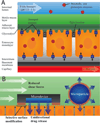Planar bioadhesive microdevices: a new technology for oral drug delivery
- PMID: 25219863
- PMCID: PMC4227534
- DOI: 10.2174/1389201015666140915152706
Planar bioadhesive microdevices: a new technology for oral drug delivery
Abstract
The oral route is the most convenient and least expensive route of drug administration. Yet, it is accompanied by many physiological barriers to drug uptake including low stomach pH, intestinal enzymes and transporters, mucosal barriers, and high intestinal fluid shear. While many drug delivery systems have been developed for oral drug administration, the physiological components of the gastro intestinal tract remain formidable barriers to drug uptake. Recently, microfabrication techniques have been applied to create micron-scale devices for oral drug delivery with a high degree of control over microdevice size, shape, chemical composition, drug release profile, and targeting ability. With precise control over device properties, microdevices can be fabricated with characteristics that provide increased adhesion for prolonged drug exposure, unidirectional release which serves to avoid luminal drug loss and enhance drug permeation, and protection of a drug payload from the harsh environment of the intestinal tract. Here we review the recent developments in microdevice technology and discuss the potential of these devices to overcome unsolved challenges in oral drug delivery.
Conflict of interest statement
None declared.
Figures






Similar articles
-
Micro/nanofabricated platforms for oral drug delivery.J Control Release. 2015 Dec 10;219:431-444. doi: 10.1016/j.jconrel.2015.07.033. Epub 2015 Aug 2. J Control Release. 2015. PMID: 26244713 Free PMC article. Review.
-
Fabrication of Sealed Nanostraw Microdevices for Oral Drug Delivery.ACS Nano. 2016 Jun 28;10(6):5873-81. doi: 10.1021/acsnano.6b00809. Epub 2016 Jun 13. ACS Nano. 2016. PMID: 27268699 Free PMC article.
-
Bioadhesive microdevices with multiple reservoirs: a new platform for oral drug delivery.J Control Release. 2002 Jun 17;81(3):291-306. doi: 10.1016/s0168-3659(02)00074-3. J Control Release. 2002. PMID: 12044568
-
Pharmaceutical approaches to colon targeted drug delivery systems.J Pharm Pharm Sci. 2003 Jan-Apr;6(1):33-66. J Pharm Pharm Sci. 2003. PMID: 12753729 Review.
-
Emerging microtechnologies for the development of oral drug delivery devices.Adv Drug Deliv Rev. 2012 Nov;64(14):1569-78. doi: 10.1016/j.addr.2012.08.013. Epub 2012 Sep 6. Adv Drug Deliv Rev. 2012. PMID: 22981755 Free PMC article. Review.
Cited by
-
Glucose-Based Mesoporous Carbon Nanospheres as Functional Carriers for Oral Delivery of Amphiphobic Raloxifene: Insights into the Bioavailability Enhancement and Lymphatic Transport.Pharm Res. 2016 Mar;33(3):792-803. doi: 10.1007/s11095-015-1827-7. Epub 2015 Nov 9. Pharm Res. 2016. PMID: 26553355
-
Bottom-Up Fabrication of Multilayer Enteric Devices for the Oral Delivery of Peptides.Pharm Res. 2019 Apr 19;36(6):89. doi: 10.1007/s11095-019-2618-3. Pharm Res. 2019. PMID: 31004235
-
Fabrication of micropatterned polymeric nanowire arrays for high-resolution reagent localization and topographical cellular control.Nano Lett. 2015 Mar 11;15(3):1540-6. doi: 10.1021/nl503872p. Epub 2015 Feb 5. Nano Lett. 2015. PMID: 25639724 Free PMC article.
-
Impact of Microdevice Geometry on Transit and Retention in the Murine Gastrointestinal Tract.ACS Biomater Sci Eng. 2023 Jun 12;9(6):2891-2901. doi: 10.1021/acsbiomaterials.0c01606. Epub 2021 Apr 29. ACS Biomater Sci Eng. 2023. PMID: 33914503 Free PMC article.
-
Micro/nanofabricated platforms for oral drug delivery.J Control Release. 2015 Dec 10;219:431-444. doi: 10.1016/j.jconrel.2015.07.033. Epub 2015 Aug 2. J Control Release. 2015. PMID: 26244713 Free PMC article. Review.
References
-
- International Transporter C, Giacomini KM, Huang SM, Tweedie DJ, Benet LZ, Brouwer KL, Chu X, Dahlin A, Evers R, Fischer V, Hillgren KM, Hoffmaster KA, Ishikawa T, Keppler D, Kim RB, Lee CA, Niemi M, Polli JW, Sugiyama Y, Swaan PW, Ware JA, Wright SH, Yee SW, Zamek-Gliszczynski MJ, Zhang L. Membrane transporters in drug development. Nature reviews. Drug discovery. 2010;9(3):215–236. - PMC - PubMed
-
- Thanki K, Gangwal RP, Sangamwar AT, Jain S. Oral delivery of anticancer drugs: challenges and opportunities. Journal of controlled release : official journal of the Controlled Release Society. 2013;170(1):15–40. - PubMed
-
- Goldberg M, Gomez-Orellana I. Challenges for the oral delivery of macromolecules. Nature reviews. Drug discovery. 2003;2(4):289–295. - PubMed
-
- Gupta S, Jain A, Chakraborty M, Sahni JK, Ali J, Dang S. Oral delivery of therapeutic proteins and peptides: a review on recent developments. Drug delivery. 2013;20(6):237–246. - PubMed
-
- Agrawal U, Sharma R, Gupta M, Vyas SP. Is nanotechnology a boon for oral drug delivery? Drug discovery today. 2014 - PubMed
Publication types
MeSH terms
Substances
Grants and funding
LinkOut - more resources
Full Text Sources
Other Literature Sources

